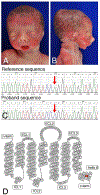Loss-of-function of Endothelin receptor type A results in Oro-Oto-Cardiac syndrome
- PMID: 32133772
- PMCID: PMC7202054
- DOI: 10.1002/ajmg.a.61531
Loss-of-function of Endothelin receptor type A results in Oro-Oto-Cardiac syndrome
Abstract
Craniofacial morphogenesis is regulated in part by signaling from the Endothelin receptor type A (EDNRA). Pathogenic variants in EDNRA signaling pathway components EDNRA, GNAI3, PCLB4, and EDN1 cause Mandibulofacial Dysostosis with Alopecia (MFDA), Auriculocondylar syndrome (ARCND) 1, 2, and 3, respectively. However, cardiovascular development is normal in MFDA and ARCND individuals, unlike Ednra knockout mice. One explanation may be that partial EDNRA signaling remains in MFDA and ARCND, as mice with reduced, but not absent, EDNRA signaling also lack a cardiovascular phenotype. Here we report an individual with craniofacial and cardiovascular malformations mimicking the Ednra -/- mouse phenotype, including a distinctive micrognathia with microstomia and a hypoplastic aortic arch. Exome sequencing found a novel homozygous missense variant in EDNRA (c.1142A>C; p.Q381P). Bioluminescence resonance energy transfer assays revealed that this amino acid substitution in helix 8 of EDNRA prevents recruitment of G proteins to the receptor, abrogating subsequent receptor activation by its ligand, Endothelin-1. This homozygous variant is thus the first reported loss-of-function EDNRA allele, resulting in a syndrome we have named Oro-Oto-Cardiac Syndrome. Further, our results illustrate that EDNRA signaling is required for both normal human craniofacial and cardiovascular development, and that limited EDNRA signaling is likely retained in ARCND and MFDA individuals. This work illustrates a straightforward approach to identifying the functional consequence of novel genetic variants in signaling molecules associated with malformation syndromes.
Keywords: Auriculocondylar syndrome; BRET; cardiovascular; micrognathia; neural crest cell.
© 2020 Wiley Periodicals, Inc.
Figures





Similar articles
-
Viable Ednra Y129F mice feature human mandibulofacial dysostosis with alopecia (MFDA) syndrome due to the homologue mutation.Mamm Genome. 2016 Dec;27(11-12):587-598. doi: 10.1007/s00335-016-9664-5. Epub 2016 Sep 26. Mamm Genome. 2016. PMID: 27671791 Free PMC article.
-
Mutations in the endothelin receptor type A cause mandibulofacial dysostosis with alopecia.Am J Hum Genet. 2015 Apr 2;96(4):519-31. doi: 10.1016/j.ajhg.2015.01.015. Epub 2015 Mar 12. Am J Hum Genet. 2015. PMID: 25772936 Free PMC article.
-
Understanding the basis of auriculocondylar syndrome: Insights from human, mouse and zebrafish genetic studies.Am J Med Genet C Semin Med Genet. 2013 Nov;163C(4):306-17. doi: 10.1002/ajmg.c.31376. Epub 2013 Oct 4. Am J Med Genet C Semin Med Genet. 2013. PMID: 24123988 Free PMC article. Review.
-
A familial PLCB4 mutation causing auriculocondylar syndrome 2 with variable severity.Eur J Med Genet. 2020 Jun;63(6):103917. doi: 10.1016/j.ejmg.2020.103917. Epub 2020 Mar 19. Eur J Med Genet. 2020. PMID: 32201334
-
Auriculocondylar syndrome: Pathogenesis, clinical manifestations and surgical therapies.J Formos Med Assoc. 2023 Sep;122(9):822-842. doi: 10.1016/j.jfma.2023.04.024. Epub 2023 May 17. J Formos Med Assoc. 2023. PMID: 37208246 Review.
Cited by
-
Mandibulofacial dysostosis with alopecia results from ETAR gain-of-function mutations via allosteric effects on ligand binding.J Clin Invest. 2023 Feb 15;133(4):e151536. doi: 10.1172/JCI151536. J Clin Invest. 2023. PMID: 36637912 Free PMC article.
-
The Gq/11 family of Gα subunits is necessary and sufficient for lower jaw development.bioRxiv [Preprint]. 2024 Sep 19:2024.09.17.611698. doi: 10.1101/2024.09.17.611698. bioRxiv. 2024. Update in: Development. 2025 Apr 15;152(8):dev204396. doi: 10.1242/dev.204396. PMID: 39345358 Free PMC article. Updated. Preprint.
-
Transcriptomic analysis reveals the role of SIX1 in mouse cranial neural crest patterning and bone development.Dev Dyn. 2023 Oct;252(10):1303-1315. doi: 10.1002/dvdy.597. Epub 2023 May 15. Dev Dyn. 2023. PMID: 37183792 Free PMC article.
-
Investigation of candidate genes and mechanisms underlying obesity associated type 2 diabetes mellitus using bioinformatics analysis and screening of small drug molecules.BMC Endocr Disord. 2021 Apr 26;21(1):80. doi: 10.1186/s12902-021-00718-5. BMC Endocr Disord. 2021. PMID: 33902539 Free PMC article.
-
Angiotensin and Endothelin Receptor Structures With Implications for Signaling Regulation and Pharmacological Targeting.Front Endocrinol (Lausanne). 2022 Apr 19;13:880002. doi: 10.3389/fendo.2022.880002. eCollection 2022. Front Endocrinol (Lausanne). 2022. PMID: 35518926 Free PMC article. Review.
References
-
- Clouthier DE, Hosoda K, Richardson JA, Williams SC, Yanagisawa H, Kuwaki T, … Yanagisawa M. (1998). Cranial and cardiac neural crest defects in endothelin-A receptor-deficient mice. Development, 125, 813–824.
Publication types
MeSH terms
Substances
Supplementary concepts
Grants and funding
LinkOut - more resources
Full Text Sources
Medical
Research Materials
Miscellaneous

